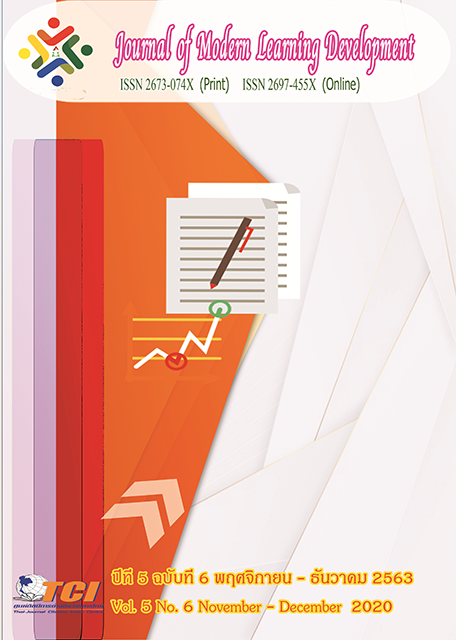Home Designing Guidelines for the Customers in Muang Sakon Nakhon District, Sakon Nakhon Province
Main Article Content
Abstract
The objectives of this research were 1) the components of home design for the customers in Muang Sakon Nakhon District, Sakon Nakhon Province, 2) to determine the name and meaning of elements for home design and 3) to creating guidelines for the development of home designs. This research was a mixed method research that used document reserch, interview and quantitative research. Sampling group included 2 groups whom 18 architects form purposive sampling and 500 respondents who want to buy a home form convenience sampling. The data were collected by interview and questionnaires. The statistics used were percentage and exploratory factor analysis.
The following were the results: 1. the components of home design for the customers in Muang Sakon Nakhon District, Sakon Nakhon Province can classify 11 elements.
2.The components of home design were (1) Home electrical design, (2) Oxygen ventilation design, (3) Material quality design, (4) Environmental safety design, (5) Allocation design, (6) Temperature living design, (7) Saving energy design, (8) Attribute comfortable design, (9) Knocking best community design, (10) Open relational design (11) Natural engagement design. All components explained 65.117 %.
3.The home design guideline defined as a concept “HOME AT SAKON” in order to meet the needs and add convenience to consumers.
Article Details
References
กัลยา วานิชย์บัญชา. (2557). การวิเคราะห์สถิติ. (พิมพ์ครั้งที่ 16). กรุงเทพมหานคร: สำนักพิมพ์แห่งจุฬาลงกรณ์มหาวิทยาลัย.
กิติ สินธุเสก. (2553). การออกแบบภายในขั้นพื้นฐาน : หลักการพิจารณาเบื้องต้น. (พิมพ์ครั้งที่ 7). กรุงเทพฯ: ภาควิชาสถาปัตยกรรมศาสตร์ จุฬาลงกรณ์มหาวิทยาลัย.
คำนวณ คุณาพร. (2552). บ้านแสนรัก. (พิมพ์ครั้งที่ 4). กรุงเทพมหานคร: วิทยพัฒน์.
เฉลิมวัฒน์ ตันตสวัสดิ์ และดารณี จารีมิตร. (2549). การออกแบบและจัดการอาคาร. กรุงเทพมหานคร: คณะสถาปัตยกรรมศาสตร์และการผังเมือง มหาวิทยาลัยธรรมศาสตร์.
ปรีดา จันทวงษ์. (2556). การศึกษาเปรียบเทียบทดสอบระหว่างหลังคาทั่วไปกับปล่องหลังคาโซล่าร์เซลล์ระบายอากาศแบบธรรมชาติร่วมกับพัดลมไฟฟ้ากระแสตรงและวิเคราะห์ต้นทุนวงจรชีวิต. วารสารวิชาการพระจอมเกล้าพระนครเหนือ, 23 (1), 104-114.
ภัทริน จิตรกร. (2561). Smart design houses ยากเพื่อง่าย. กรุงเทพมหานคร: บ้านและสวน.
ภูมิชาย พันธุ์ไพโรจน์. (2563). ลักษณะของที่อยู่อาศัยผู้มีรายได้น้อย ย่านรังสิต จังหวัดปทุมธานี: การต่อเติมและดัดแปลงโครงการที่อยู่อาศัยของรัฐ. วารสารวิจัยและสาระสถาปัตยกรรม / การผังเมือง, 17(1), 43-64.
มาโนช ประภาษานนท์. (2553). แต่งเติมเสริมฮวงจุ้ย. (พิมพ์ครั้งที่ 7). กรุงเทพมหานคร: มติชน.
ยอดเยี่ยม เทพธรานนท์. (2551). สารพันคำตอบ เรื่องบ้านกับสถาปนิกไทย. กรุงเทพมหานคร: ซีเอ็ดยูเคชั่น.
ศักดา ประสานไทย (2553). คู่มือปลูกบ้าน (ฉบับปรับปรุง). กรุงเทพมหานคร: ซีเอ็ดยูเคชั่น.
สำนักงานสถิติจังหวัดสกลนคร. (2561). สำมะโนประชากร และครัวเรือน. ออนไลน์. สืบค้นเมื่อ 11 มีนาคม 2563. แหล่งที่มา: http://webhost.nso.go.th/nso/project/search_cen/ result_by_department.jsp
สุชน ยิ้มรัตนบวร. (2561). การพัฒนาการออกแบบบ้านพักอาศัยสำหรับผู้สูงวัยด้วยหลักการออกแบบสำหรับคนทุกวัย. วารสารวิชาการคณะสถาปัตยกรรมศาสตร์ สจล., 26(1), 173-188.
องุ่นทิพย์ ศรีสุวรรณ. (2559). การใช้งานและการส่องสว่างในพื้นที่สาธารณะในเขตเมืองเชียงใหม่. วารสารวิชาการการออกแบบสภาพแวดล้อม, 3(2), 73-98.
ไอรีน สิทธิชัย. (2560). พื้นที่เพื่อการนอนหลับ. วิทยานิพนธ์ปริญญาสถาปัตยกรรมศาสตร์. คณะสถาปัตยกรรมศาสตร์: มหาวิทยาลัยศรีปทุม.
Comrey, A. & Lee, H. (1992). A First Course in Factor Analysis. Hillsdale: Erlbaum.
Sekaran, U. & Bougie, R. (2013). Research Methods for Business. (6th ed). Hoboken, NJ: John Wiley & Sons.


